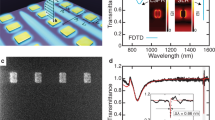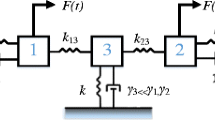Abstract
A new configuration for metasurface construction is presented to exhibit potential multi-functionalities including perfect absorption, bio/chem sensing, and enhancement of light–matter interaction. The reciprocal plasmonic metasurfaces discussed here are composed of two plasmonic surfaces of reciprocal geometries separated by a dielectric spacer. Compared to conventional metasurfaces this simple geometry exhibits an enhanced optical performance due to the hybrid plasmonic–photonic cavity. The discussed reciprocal metasurface design further enables effective structural optimization and allows for a simple and scalable fabrication. The physical principle and potential applications of the reciprocal plasmonic metasurfaces are demonstrated using numerical and analytical approaches.





Similar content being viewed by others
References
Cai W, Shalaev V (2009) Optical Metamaterials: Fundamentals and Applications. Springer Science & Business Media
Landy N, Sajuyigbe S, Mock JJ, Smith DR, Padilla WJ (2008) Perfect metamaterial absorber. Phys Rev Lett 100(20):207402
Chen HT, Zhou J, O’Hara JF, Chen F, Azad AK, Taylor AJ (2010) Antireflection coating using metamaterials and identification of its mechanism. Phys Rev Lett 105(7):073901
Ameling R, Langguth L, Hentschel M, Mesch M, Braun PV, Giessen H (2010) Cavity-enhanced localized plasmon resonance sensing. Appl Phys Lett 97(25):253116
Shchegolkov DY, Azad A, O’hara J, Simakov E (2010) Perfect subwavelength fishnetlike metamaterial-based film terahertz absorbers. Phys Rev B 82(20):205117
Pu M, Hu C, Wang M, Huang C, Zhao Z, Wang C, Feng Q, Luo X (2011) Design principles for infrared wide-angle perfect absorber based on plasmonic structure. Opt Express 19(18):17413–17420
Vázquez-Guardado A, Safaei A, Modak S, Franklin D, Chanda D (2014) Hybrid coupling mechanism in a system supporting high order diffraction, plasmonic, and cavity resonances. Phys Rev Lett 113(26):263902
Wang BX, He Y, Lou P, Zhu H (2021) Multi-band terahertz superabsorbers based on perforated square-patch metamaterials. Nanoscale Adv 3(2):455–462
Wang BX, He Y, Lou P, Xing W (2020) Design of a dual-band terahertz metamaterial absorber using two identical square patches for sensing application. Nanoscale Adv 2(2):763–769
Wang BX, Tang C, Niu Q, He Y, Chen R (2019) A broadband terahertz metamaterial absorber enabled by the simple design of a rectangular-shaped resonator with an elongated slot. Nanoscale Adv 1(9):3621–3625
Ye YQ, Jin Y, He S (2010) Omnidirectional, polarization-insensitive and broadband thin absorber in the terahertz regime. JOSA B 27(3):498–504
Wu C, Burton Neuner I, Shvets G, John J, Milder A, Zollars B, Savoy S (2011) Large-area wide-angle spectrally selective plasmonic absorber. Phys Rev B 84(7):075102
Zhang B, Zhao Y, Hao Q, Kiraly B, Khoo IC, Chen S, Huang TJ (2011) Polarization-independent dual-band infrared perfect absorber based on a metal-dielectric-metal elliptical nanodisk array. Opt Express 19(16):15221–15228
Chen K, Dao TD, Ishii S, Aono M, Nagao T (2015) Infrared aluminum metamaterial perfect absorbers for plasmon-enhanced infrared spectroscopy. Adv Funct Mater 25(42):6637–6643
Feng Q, Pu M, Hu C, Luo X (2012) Engineering the dispersion of metamaterial surface for broadband infrared absorption. Opt Lett 37(11):2133–2135
Shrestha S, Wang Y, Overvig AC, Lu M, Stein A, Negro LD, Yu N (2018) Indium tin oxide broadband metasurface absorber. ACS Photonics 5(9):3526–3533
Liu N, Mesch M, Weiss T, Hentschel M, Giessen H (2010) Infrared perfect absorber and its application as plasmonic sensor. Nano Lett 10(7):2342–2348
Artar A, Yanik AA, Altug H (2009) Fabry-pérot nanocavities in multilayered plasmonic crystals for enhanced biosensing. Appl Phys Lett 95(5):051105
Lu X, Wan R, Zhang T (2015) Metal-dielectric-metal based narrow band absorber for sensing applications. Opt Express 23(23):29842–29847
Hentschel M, Weiss T, Bagheri S, Giessen H (2013) Babinet to the half: coupling of solid and inverse plasmonic structures. Nano Lett 13(9):4428–4433
Wang BX, Wang GZ, Wang LL (2016) Design of a novel dual-band terahertz metamaterial absorber. Plasmonics 11(2):523–530
Dao TD, Doan AT, Ngo DH, Chen K, Ishii S, Tamanai A, Nagao T (2019) Selective thermal emitters with infrared plasmonic indium tin oxide working in the atmosphere. Opt Mater Express 9(6):2534–2544
Dao TD, Chen K, Ishii S, Ohi A, Nabatame T, Kitajima M, Nagao T (2015) Infrared perfect absorbers fabricated by colloidal mask etching of Al-Al2O3-Al trilayers. ACS Photonics 2(7):964–970
D’Archangel JA, Shelton DJ, Hudgins R, Poutous MK, Boreman GD (2014) Large area infrared frequency selective surface with dimensions reproducible by optical lithography. J Vac Sci Technol B Nanotechnol Microelectron: Mater Process Meas Phenom 32(5):051807
Chen HT (2012) Interference theory of metamaterial perfect absorbers. Opt Express 20(7):7165–7172
Li Y, Fullager D, Angelbello E, Childers D, Boreman G, Hofmann T (2018) Broadband near-infrared antireflection coatings fabricated by three-dimensional direct laser writing. Opt Lett 43(2):239–242
Li Y, Park S, McLamb M, Lata M, Schöche S, Childers D, Aggarwal I, Poutous M, Boreman G, Hofmann T (2019) UV to NIR optical properties of IP-Dip, IP-L, and IP-S after two-photon polymerization determined by spectroscopic ellipsometry. Opt Mater Express 9(11):4318–4328
Li Y, Fullager D, Park S, Childers D, Fesperman R, Boreman G, Hofmann T (2018) High-contrast infrared polymer photonic crystals fabricated by direct laser writing. Opt Lett 43(19):4711–4714
Fullager DB, Boreman GD, Hofmann T (2017) Infrared dielectric response of nanoscribe IP-Dip and IP-L monomers after polymerization from 250 cm\(^{- 1}\) to 6000 cm\(^{- 1}\). Opt Mater Express 7(3):888–894
Sherry LJ, Chang SH, Schatz GC, Van Duyne RP, Wiley BJ, Xia Y (2005) Localized surface plasmon resonance spectroscopy of single silver nanocubes. Nano Lett 5(10):2034–2038
Becker J, Trügler A, Jakab A, Hohenester U, Sönnichsen C (2010) The optimal aspect ratio of gold nanorods for plasmonic bio-sensing. Plasmonics 5(2):161–167
Lee Y, Kim SJ, Park H, Lee B (2017) Metamaterials and metasurfaces for sensor applications. Sensors 17(8):1726
Wang BX, Wang GZ, Sang T (2016) Simple design of novel triple-band terahertz metamaterial absorber for sensing application. J Phys D Appl Phys 49(16):165307
Funding
The authors are grateful for support from the National Science Foundation (1624572) within the IUCRC Center for Metamaterials and through the NSF MRI 1828430, the Army Research Office (W911NF-14-1-0299) and the Department of Physics and Optical Science of the University of North Carolina at Charlotte.
Author information
Authors and Affiliations
Contributions
Y.L. developed the theory and the numerical simulations and took the lead in writing the manuscript with support from M.M. and S.P.. D.C. provided the funding support and critical discussions. G.D.B. offered insightful feedback and helped shape the analysis and manuscript. T.H. contributed to the final version of the manuscript and supervised the research project.
Corresponding author
Ethics declarations
Competing Interests
The authors declare no conflicts of interest.
Additional information
Publisher’s Note
Springer Nature remains neutral with regard to jurisdictional claims in published maps and institutional affiliations.
Rights and permissions
About this article
Cite this article
Li, Y., McLamb, M., Park, S. et al. Theoretical Study of Enhanced Plasmonic–Photonic Hybrid Cavity Modes in Reciprocal Plasmonic Metasurfaces. Plasmonics 16, 2241–2247 (2021). https://doi.org/10.1007/s11468-021-01456-z
Received:
Accepted:
Published:
Issue Date:
DOI: https://doi.org/10.1007/s11468-021-01456-z




